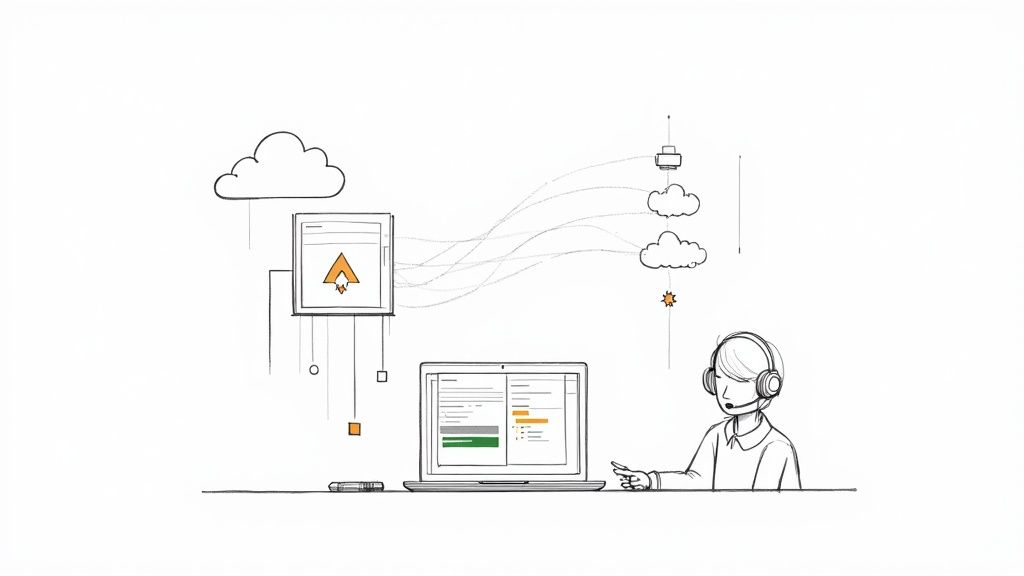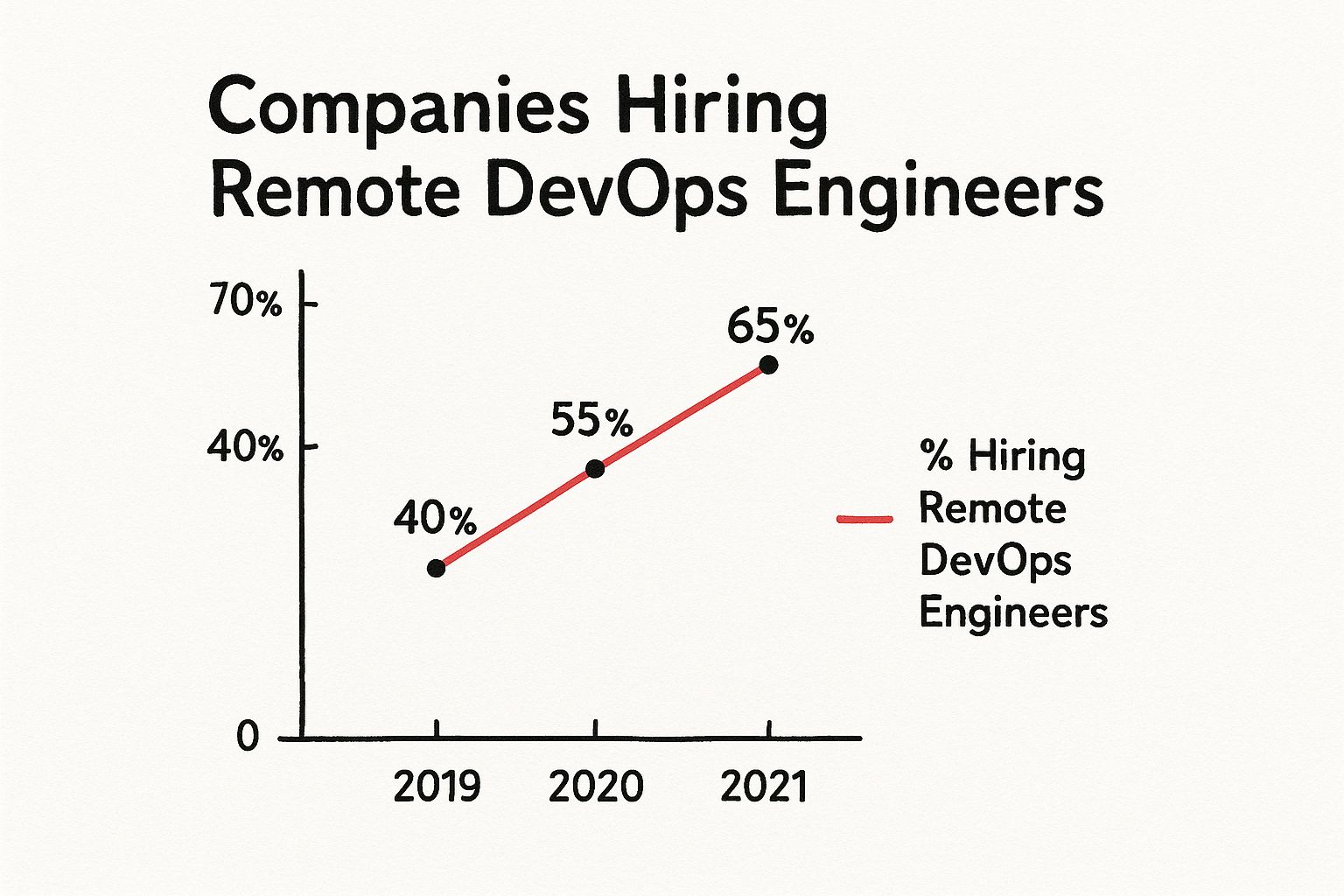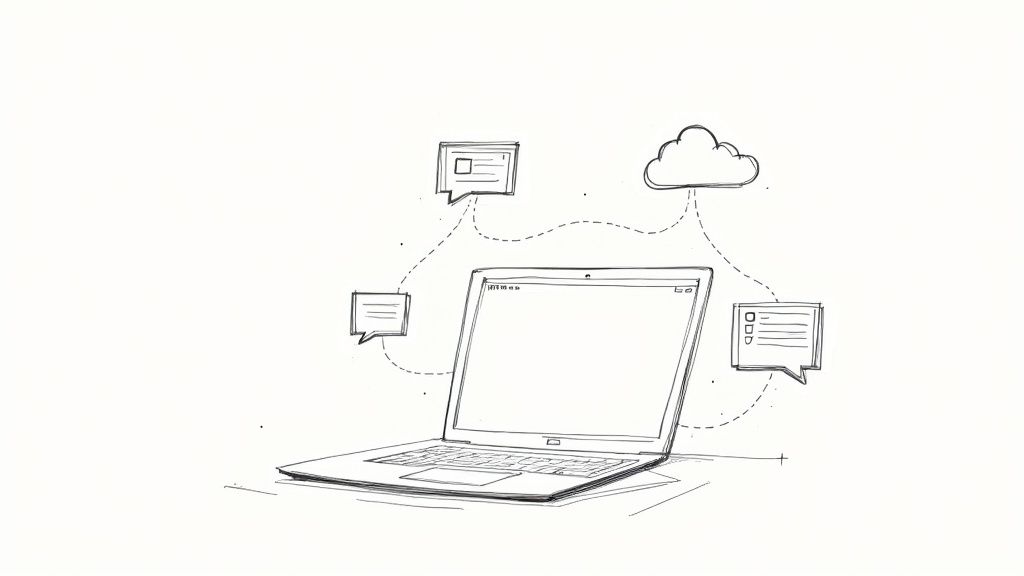How to Hire a Remote DevOps Engineer: A Technical Guide
Learn how to hire a remote DevOps engineer with our expert guide. Find, interview, and onboard top talent for your distributed team today.

Before you post a job ad, the first critical step is to architect the role. This isn't just listing tools; it's about a deep analysis of your current infrastructure and operational pain points to define exactly what problems this engineer needs to solve. Success hinges on this initial blueprint.
To get there, you need to start with a rigorous, honest audit of your own systems.
Defining the Role Beyond a Job Description
What are your biggest infrastructure bottlenecks right now? Is your Kubernetes cluster suffering from pod eviction storms due to resource contention, indicating a need for better resource management and autoscaling strategies? Or is the immediate challenge automating deployments for a monolithic legacy application using a canary or blue-green strategy without causing downtime? Pinpointing these specific, technical pain points is paramount.
The demand for skilled DevOps talent is surging. The global market is projected to skyrocket from $13.2 billion in 2024 to $81.1 billion by 2028. With approximately 80% of companies now adopting DevOps principles, it’s no surprise that 29% of IT teams have recently hired for this role. It is a highly competitive market.
This chart drives home the point, showing just how quickly companies are embracing remote DevOps engineers.

The upward trend is undeniable, signaling a clear industry shift and growing trust in remote talent to manage mission-critical infrastructure.
Distinguishing Must-Haves from Nice-to-Haves
Once you’ve identified your core challenges, you must separate non-negotiable "must-have" skills from "nice-to-haves." An unrealistic wish list of every tool under the sun will deter qualified candidates.
For example, if your entire infrastructure is codified in Terraform and runs on AWS, then deep, hands-on experience with both is a hard requirement. The candidate must be able to write complex modules, manage state effectively, and understand IAM policies in depth.
However, if you use Prometheus for monitoring but are considering a migration, specific Prometheus expertise is a bonus, not a deal-breaker. A candidate with deep experience in a different observability platform like Datadog or setting up a custom OpenTelemetry stack could adapt quickly.
To aid this process, define the seniority level you need. A junior engineer's responsibilities and technical depth will be vastly different from a principal-level architect.
Core DevOps Competencies by Experience Level
| Experience Level | Core Technical Skills | Key Responsibilities |
|---|---|---|
| Junior | Foundational cloud services (e.g., AWS EC2, S3, IAM), shell scripting (Bash, PowerShell), CI/CD pipeline usage (Jenkins, GitLab CI), containerization (Docker). | Executing predefined runbooks, maintaining CI/CD jobs, basic cloud resource provisioning via console or simple scripts, responding to tier-1 monitoring alerts. |
| Mid-Level | Advanced IaC (Terraform, CloudFormation), container orchestration (Kubernetes), strong observability (Prometheus, Grafana), CI/CD pipeline design, security fundamentals. | Designing and implementing CI/CD pipelines, writing and maintaining complex IaC modules, improving system reliability (SLIs/SLOs), automating toil. |
| Senior | Deep cloud architecture expertise (multi-account strategies, VPC design), advanced Kubernetes management (custom controllers, service mesh), DevSecOps practices, cloud cost optimization. | Architecting scalable and resilient cloud-native systems, leading infrastructure projects, setting technical strategy, mentoring other engineers, driving security and compliance. |
This table provides a solid baseline to help you target the precise level of expertise your specific technical challenges demand.
Building a Precise Candidate Persona
With your technical requirements defined, build a detailed candidate persona. This transcends a skills checklist; it encompasses the operational and cultural attributes required for success on a remote team.
Consider these factors:
- Level of Autonomy: Do you need a self-directed engineer who can take a high-level objective like "improve deployment velocity" and break it down into actionable epics? Or will this role have close oversight from a lead? A startup scaling its infrastructure needs the former; a large enterprise with established processes might offer more structure.
- Communication Protocol: Remote work is defined by communication. Is your team synchronous, relying on frequent video calls and pair programming sessions? Or is it asynchronous, with a culture built on detailed RFCs, architecture decision records (ADRs), and thorough pull request descriptions in tools like Slack or Jira? Your ideal hire must thrive in your operational rhythm. We delve deeper into this in our guide on the role of a remote DevOps engineer.
- Problem-Solving Approach: Do you need a methodical architect who designs for five-nines of availability? Or do you need a pragmatic troubleshooter who excels at incident response and can quickly diagnose production issues? Be honest about your team's current needs.
By architecting this detailed persona, you transform your hiring process. You stop looking for a list of tool keywords and start searching for an engineer who can solve your specific architectural and operational problems within your remote culture. This foundation is the single most critical factor in a successful hire.
Finding Elite DevOps Talent in a Crowded Market

The best remote DevOps engineers are not endlessly scrolling job boards. They are busy resolving complex infrastructure issues, contributing to open-source projects, or engaging in deep technical debates within their peer communities.
To hire this caliber of talent, you must operate where they do. This requires moving beyond passive job postings and actively sourcing from platforms where technical credibility is built and demonstrated. It's less like casting a wide net and more like targeted reconnaissance.
Beyond the Job Board Horizon
Standard job sites generate high volume but low signal. The true experts are often passive candidates—not actively looking, but open to a compelling technical challenge. Your strategy must be to identify these individuals by analyzing their digital contributions.
These are the primary sourcing channels:
- Open-Source Project Contributors: The contributor list for a key open-source project in your stack is a goldmine. If you rely on Kubernetes, Terraform, or Ansible, analyze the commit histories. Who is fixing complex bugs in the scheduler or storage plugins? Who is contributing significant new features? These individuals have proven, peer-reviewed expertise.
- Niche DevOps Communities: Platforms like the HashiCorp forums, the CNCF (Cloud Native Computing Foundation) Slack workspace, or specialized Discord servers are where engineers solve real-world problems. Observing these communities reveals who provides the most insightful and helpful answers. They are the de facto experts.
- Technical Conference Speaker Lists: Review speaker lists from past DevOps conferences like KubeCon, AWS re:Invent, or SREcon. These are recognized subject matter experts, selected for their ability to articulate complex technical concepts clearly.
Treat sourcing like an engineering problem. Define your target profiles, identify the right channels, craft a specific and compelling message (your outreach), and measure the response rate to iterate and improve. Don't post and pray; actively pursue the engineers who can solve your specific technical challenges.
Writing the Un-Job-Description
Forget the generic template of responsibilities and qualifications. A top-tier DevOps engineer responds to a technical challenge, not corporate jargon. Your job description should read like a concise technical brief or mission statement.
Structure it to answer an engineer's primary questions immediately:
- What's the core infrastructure challenge? Lead with the problem. "We are migrating a monolithic application to a microservices architecture on EKS and need an expert to design and implement our service mesh (Istio/Linkerd) and GitOps-based CI/CD strategy."
- What's the current tech stack? Be precise and transparent. List your cloud provider, IaC tools (Terraform version, state backend), container orchestrator (Kubernetes version, CNI plugin), monitoring stack (Prometheus, Grafana, Alertmanager), and primary scripting languages.
- What is the direct impact of this role? Connect their work to a measurable business outcome. "You will be responsible for reducing our P95 API latency by 50% by optimizing our ingress controller and service-to-service communication," or "Your work will directly improve application uptime from 99.9% to 99.99% by implementing automated failover mechanisms."
- What does success look like in 90 days? Provide a clear, tangible objective. "By the end of your first quarter, you will have fully automated our staging environment provisioning using Terraform and integrated it into our GitLab CI pipeline, reducing environment spin-up time from 4 hours to 15 minutes."
This approach acts as a natural filter, attracting engineers who are genuinely excited by your technical roadmap and repelling those who are not a good fit.
Crafting Outreach That Gets a Reply
When you identify a promising candidate, your initial message is critical. Generic, copy-pasted outreach is instantly discarded. Your message must be personalized, concise, and centered on the technical work. For more on this, see the insights in Mastering Recruitment for Engineering in a Tough Market.
A successful outreach message follows this pattern:
- Subject: Question about your [Project/Contribution] & a challenge at [Your Company]
- Body: "Hi [Candidate Name], I saw your recent PR to the [Open-Source Project] that refactored [specific component]. The approach you took to [technical detail] was impressive. At [Your Company], we're tackling a similar scaling challenge with our [describe your technical problem]. Given your expertise in [relevant technology], I thought you might find our architecture interesting. Would you be open to a brief, no-pressure technical chat about it?"
This works because it is rooted in respect for their demonstrated skill. It frames the conversation as a peer-level technical discussion, not a recruitment pitch, and is the first step in building the rapport necessary to attract top talent for the best https://opsmoon.com/blog/remote-devops-engineer-jobs.
Running a Technical Interview That Predicts Performance

Generic algorithm questions are ineffective for this role.
Knowing how to invert a binary tree offers zero insight into a candidate's ability to debug a failing CI/CD pipeline under pressure. To hire an effective remote DevOps engineer, your interview process must simulate the real-world, high-stakes challenges they will face.
The goal is to move beyond abstract puzzles and construct a multi-stage technical assessment that accurately predicts on-the-job performance. This requires a combination of hands-on challenges, system design discussions, and a critical evaluation of their remote collaboration skills.
The Initial Technical Screening Call
Before a time-intensive challenge, conduct a 30-45 minute screening call led by a senior engineer. This is not a culture-fit chat; it is a targeted conversation to validate foundational knowledge and eliminate candidates with only surface-level understanding.
Avoid closed-ended questions like "Do you know Kubernetes?" Instead, ask open-ended, probing questions:
- "Trace the lifecycle of a request in a Kubernetes cluster, starting from a user hitting an ingress endpoint, through the service, to the pod, and back. Describe the key components involved, like kube-proxy and CoreDNS."
- "Describe a time you had to debug a slow
terraform plan. What were the potential root causes you investigated, and what tools did you use to optimize it?" - "How would you securely manage sensitive secrets, such as database credentials or API keys, within a GitLab CI/CD pipeline? Discuss the pros and cons of different methods like environment variables, Vault integration, or cloud-provider secret managers."
These questions are designed to elicit a thought process, revealing practical experience and problem-solving methodology. This screen saves significant time for both parties.
The Hands-On Practical Challenge
A well-designed, practical challenge is the single most effective predictor of future performance. It should be a take-home assignment that mirrors a task they would encounter in their first few months.
This assignment must be a microcosm of your actual infrastructure and its challenges.
Example Scenarios for a Take-Home Assignment:
- Containerize and Deploy an Application: Provide a simple application (e.g., a Python Flask app with a Redis dependency). The task is to write a multi-stage Dockerfile, create a
docker-compose.ymlfor local development, and then write a basic Kubernetes manifest (Deployment, Service, ConfigMap) to run it. They must document the process thoroughly in aREADME.md. - Architect a Monitoring and Alerting Solution: Present a scenario: "We have 50 microservices on GKE. Design a monitoring solution using the Prometheus Operator. Define a sample PrometheusRule for alerting on high error rates (HTTP 5xx) and explain how you would configure Alertmanager to route alerts to different teams." They should provide an architecture diagram and a brief technical document explaining their choices.
- Automate an Infrastructure Task: Describe a manual process, like provisioning a new AWS S3 bucket with specific lifecycle policies, encryption, and IAM access. Ask them to write a reusable Terraform module to automate this task, including variables for customization and outputs for consuming the resource.
Evaluate the entire submission, not just the final code. Analyze their git commit history for logical progression. Scrutinize their
README.mdfor clarity. Did they consider security principles like least privilege? Is their code modular and maintainable? This reveals far more than watching someone code under pressure.
The Live System Design and Pairing Session
The final technical stage is a live, collaborative session. This is not an interrogation; it's an opportunity to observe their thought process, communication style, and problem-solving abilities in real-time.
First, a system design discussion, using their take-home project as a starting point. Ask them to walk through their solution and justify their technical decisions. Then, introduce new constraints to see how they adapt.
- "Your logging solution using the ELK Stack (Elasticsearch, Logstash, Kibana) is solid. How would you modify it to handle 10TB of logs per day? What are the potential bottlenecks?"
- "How would you implement a zero-downtime deployment strategy for your containerized application in Kubernetes?"
Second, a live infrastructure-as-code pairing session. Share your screen and work on a small, well-defined problem together. This could be writing an Ansible playbook to configure a web server or debugging a failing Terraform module. This assesses their problem-solving methodology and collaborative skills.
Assessing Remote Collaboration Skills
Throughout the process, intentionally evaluate the skills essential for a remote DevOps engineer. Technical prowess is only half the equation; they must excel in an asynchronous, documentation-driven culture.
- Written Communication: How clear, concise, and detailed was the documentation in their take-home assignment?
- Asynchronous Problem-Solving: How did they ask for clarification on the assignment? Did they ask thoughtful, structured questions upfront?
- Receptiveness to Feedback: During the pairing session, how did they respond to suggestions or critiques of their approach?
By integrating these practical and collaborative evaluations, you move from resume keyword matching to accurately predicting a candidate’s ability to perform and add value to your remote team.
Crafting a Competitive Offer for Remote Engineers
You've successfully navigated the sourcing and interview process and identified an exceptional candidate. The final stage is making an offer they cannot refuse.
Structuring a compelling package for a remote DevOps engineer goes beyond salary. It's about creating a total value proposition that demonstrates you understand their professional and personal needs. A well-crafted offer proves you value their expertise and are invested in their long-term growth.
Nailing the Salary Conversation
Compensation is the first consideration. Determining the right base salary requires analyzing global benchmarks and defining your company's compensation philosophy.
Remote startups in the US offer an average salary for DevOps engineers of around $134,000 per year, significantly higher than the general remote startup average of $97,000. This disparity highlights the intense demand for specialized DevOps talent. You can dig into more remote DevOps salary data to analyze variations based on experience and company size.
This data forces a critical decision: will you offer location-agnostic pay (same salary for the same level, regardless of location) or location-based pay?
- Location-Agnostic Pay: Simpler to administer and often perceived as more equitable. It's particularly attractive to candidates in lower cost-of-living areas.
- Cost-of-Living Adjustments: Can be more budget-friendly but adds administrative complexity and can be a point of contention for candidates who believe their value is tied to their skills, not their location.
There is no single "right" answer, but your choice is a strong signal about your company culture.
Before making an offer, be armed with market data. Here’s a baseline for what to expect based on experience.
Remote DevOps Salary Benchmarks by Experience
This overview of average salary ranges for remote DevOps engineers provides a solid baseline for a competitive offer.
| Experience Level | Average Annual Salary Range (USD) |
|---|---|
| Junior (0-2 years) | $85,000 – $115,000 |
| Mid-Level (2-5 years) | $115,000 – $150,000 |
| Senior (5-10 years) | $150,000 – $190,000 |
| Lead/Principal (10+ years) | $190,000+ |
Note: These are general market averages. Salaries can vary based on specific skills (like Kubernetes or Terraform expertise), company size, and funding stage.
Using this data ensures your offer is both competitive and fair, enabling you to attract and retain top talent.
High-Value Benefits That Actually Matter to Remote Folks
Beyond salary, certain benefits are highly valued by remote engineers and signal that you understand the remote work paradigm.
The most common mistake is transposing an office-centric benefits package to remote roles. The key is to offer perks that tangibly improve the remote experience, supporting autonomy, professional growth, and well-being.
Consider these high-impact benefits:
- A Real Home Office Stipend: Provide a significant one-time or annual budget for ergonomic furniture, high-quality monitors, and other essential equipment. This is a direct investment in their productivity and health.
- A Dedicated Professional Development Budget: DevOps is a field of continuous learning. Earmark funds for certifications (e.g., CKA, AWS Certified DevOps Engineer – Professional), conference attendance, and online training platforms. This demonstrates a commitment to their career progression.
- Truly Flexible Hours: This is about trusting your team to manage their own schedules to achieve their objectives. It means respecting different time zones and personal commitments, fostering a culture of ownership and results over hours clocked.
Don't Skip the Details: Essential Remote Contract Clauses
Your employment contract must be precise to prevent future misunderstandings. When you hire a remote DevOps engineer, you are granting them privileged access to critical infrastructure. A well-drafted contract protects both parties.
Ensure your contract explicitly covers these areas:
Remote Contract Checklist:
- Data Security and Confidentiality: Clearly define requirements for securing company data on personal networks and devices, such as mandatory use of a VPN, full-disk encryption, and a password manager.
- Intellectual Property (IP): State unequivocally that all work produced during employment—code, scripts, IaC modules, documentation—is the exclusive property of the company.
- On-Call Expectations: This is critical. Document the on-call rotation schedule, response time SLAs, and compensation for on-call duties. Ambiguity here is a primary cause of burnout.
- Equipment Policy: Specify whether the company provides a laptop and other equipment or if the employee uses their own with a reimbursement policy.
Getting Your New Hire Up to Speed: A Remote Technical Onboarding That Works

A world-class DevOps engineer can become disengaged if their first week is a frustrating maze of access requests and outdated documentation. Effective onboarding is not optional; it must be a structured, repeatable, and immersive process.
For a remote engineer, this cannot be left to chance. The first week sets the tone for their entire tenure. It's about deep technical immersion: systematically granting secure access, explaining the architectural "why," and fostering human connections.
Your Week One Technical Immersion Checklist
From day one, focus on empowerment and context. A remote hire feels isolated when they lack system access or architectural understanding. Your goal is to eliminate these barriers immediately.
A practical checklist for success:
- Provision Secure Access Pre-Day One: Accounts for cloud consoles (AWS, GCP, Azure), Git repositories (GitHub, GitLab), CI/CD platforms (Jenkins, CircleCI), and observability systems (Datadog, Prometheus) should be ready before they start. Use an identity provider (e.g., Okta) for seamless, secure access management.
- Conduct an Architecture Deep Dive: A senior engineer should lead the new hire through infrastructure diagrams, data flow charts, and the end-to-end CI/CD pipeline. The goal is to build a mental model of the system. Record this session for future reference.
- Assign a Technical Buddy: Pair them with a senior engineer for their first few weeks for active pairing sessions on real tasks. This is the fastest way to transfer institutional knowledge and coding standards.
- Automate Local Dev Environment Setup: Provide a well-documented, automated process for bootstrapping a local development environment. Ideally, this is a single script or a Docker Compose configuration. No engineer should waste days fighting configuration drift.
The most impactful action in week one is to facilitate a small, tangible win. A "first-commit goal" within their first 48-72 hours builds momentum and confirms they made the right career choice.
The Power of the First Commit
Merging the first commit is a critical milestone. It's less about the technical complexity of the change and more about successfully navigating the entire development lifecycle, from ticket to deployment.
This small victory validates the process and signals their official status as a contributing team member.
Ideal tasks for a first commit:
- Fixing a flaky integration test in the CI pipeline.
- Refactoring a small section of a deployment script for clarity.
- Updating technical documentation that is known to be out of date.
- Adding a new metric or label to an existing Prometheus exporter.
This also serves as a test of your onboarding process. If they get stuck, it highlights a gap in your documentation or tooling that needs to be addressed.
Building Culture from Miles Away
Technical onboarding is only half the battle. Integrating a remote DevOps engineer into your culture requires deliberate effort. You must synthetically create the informal interactions that occur naturally in an office. For a deeper look, see this a comprehensive guide to onboarding remote employees.
Begin by establishing clear communication protocols. How does your team use Slack? Is it for asynchronous, threaded discussions in channels, or for quick, synchronous video huddles? Our guide on remote team collaboration tools can help you refine your toolchain.
Next, assign a non-technical "onboarding buddy" from a different department. This person is their resource for understanding company culture, key stakeholders, and the unwritten rules of the organization.
Finally, schedule regular, informal video check-ins. These are not status updates but 15-minute coffee chats designed to build the human rapport that is the foundation of high-performing teams.
Answering Your Top Questions About Hiring a DevOps Engineer
When looking to hire a remote DevOps engineer, several key questions consistently arise. Addressing these effectively is crucial for making a successful hire.
A primary concern is compensation. In 2025, the average salary for a remote DevOps engineer is approximately $110,000 per year, but this is merely a baseline.
This figure varies significantly with experience. Entry-level roles may start around $65,000, while a principal or lead engineer can command $200,000 or more. To get precise figures, you should explore detailed salary data that breaks down compensation by specific skill sets and experience levels.
How Do We Actually Vet Skills from a Distance?
This is a critical challenge. While technical skills can be assessed with a practical challenge, evaluating collaborative and communication skills remotely requires a different approach. For remote roles, these soft skills are as important as the ability to write a Terraform module.
Our recommended practices:
- Analyze Asynchronous Communication: Scrutinize their written communication throughout the process. Is the documentation for their take-home assignment clear, concise, and thorough? This provides the best insight into their day-to-day communication style.
- Conduct a Collaborative Problem-Solving Session: A live pairing session is invaluable. It reveals how they articulate their thought process, accept feedback, and work with a teammate to solve a technical problem.
A candidate who can clearly document their work and ask insightful, clarifying questions in writing is often a better fit for a remote team than one who simply excels at a solo coding puzzle. It demonstrates they can operate effectively in a distributed environment.
What Should Their First Month on the Job Look Like?
The first 30 days are foundational for long-term success. The goal is not to assign a massive project immediately but to build context and facilitate early, meaningful contributions.
A robust 30-day plan includes:
- System Immersion: Ensure they have secure access to all necessary systems on day one. Provide a thorough walkthrough of your architecture and CI/CD pipelines to help them build a mental map.
- Assign a Low-Risk First Task: Within the first week, give them a well-defined task like fixing a flaky test or improving a small script. Merging that first commit is a powerful confidence booster.
- Foster Connections: Schedule regular, informal video chats with their technical buddy and other team members. These interactions are crucial for building the professional relationships that underpin effective collaboration.
This structured approach ensures your new remote DevOps engineer feels integrated and empowered to contribute from day one, transforming them from a new hire into a valuable team member.
Ready to hire a top-tier remote DevOps engineer without the guesswork? OpsMoon connects you with the top 0.7% of global talent and provides a clear roadmap for success. Start with a free work planning session and let our Experts Matcher technology find the perfect fit for your team. Find your next elite engineer at https://opsmoon.com.
